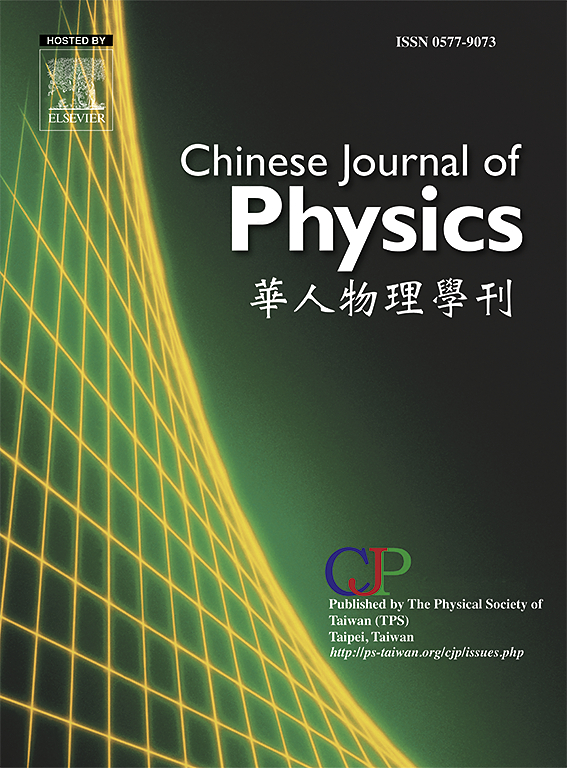通过石墨烯中间层调节Cu2Te/金属的接触特性
IF 4.6
2区 物理与天体物理
Q1 PHYSICS, MULTIDISCIPLINARY
引用次数: 0
摘要
二维通道材料与电极之间的接触特性决定了纳米器件的整体性能。近年来制备的半导体Cu2Te单层具有高载流子迁移率和优异的环境稳定性,是一种很有前途的高性能纳米器件通道材料。本文基于第一性原理计算,系统地研究了Cu2Te与各种金属(Mo, W, Sb, Cu和Ni)的接触特性以及石墨烯中间层在定制这些界面中的作用。第一性原理计算表明,通过插入石墨烯层,Cu2Te和金属电极(Mo, W, Cu和Ni)之间的强相互作用被削弱,通过功函数工程实现可调的接触类型。随着石墨烯层数的增加,Cu2Te/Mo、Cu2Te/W和Cu2Te/Cu界面上的n型欧姆触点转变为p型行为,而Cu2Te/Ni界面没有出现触点切换。通过Cu2Te/金属去耦,这种石墨烯中间层可以抑制FLP并定制接触类型,这有利于可重构纳米器件。这项工作为高性能cu2te基纳米器件的开发提供了有价值的理论见解。本文章由计算机程序翻译,如有差异,请以英文原文为准。

Tunable contact properties in Cu2Te/metals via graphene interlayer
The contact properties between two-dimensional (2D) channel materials and electrodes critically govern the overall performance of nanodevices. Recently fabricated semiconducting Cu2Te monolayer with high carrier mobility and exceptional environmental stability is a promising channel material for high-performance nanodevices. Herein, the contact properties of Cu2Te with various metals (Mo, W, Sb, Cu, and Ni) and the role of graphene interlayer in tailoring these interfaces are systematically investigated based on first-principles calculations. First-principles calculations reveal that, by intercalating graphene layers, the strong interactions between Cu2Te and metallic electrodes (Mo, W, Cu, and Ni) are weakened, enabling tunable contact types via work function engineering. The n-type Ohmic contacts at Cu2Te/Mo, Cu2Te/W, and Cu2Te/Cu interfaces transition to p-type behavior as the number of graphene layers increases, whereas Cu2Te/Ni interfaces exhibit no contact-type switching. By decoupling Cu2Te/metals, such graphene interlayers can suppress FLP and tailor contact types, which are beneficial for reconfigurable nanodevices. This work provides valuable theoretical insights for the development of high-performance Cu2Te-based nanodevices.
求助全文
通过发布文献求助,成功后即可免费获取论文全文。
去求助
来源期刊

Chinese Journal of Physics
物理-物理:综合
CiteScore
8.50
自引率
10.00%
发文量
361
审稿时长
44 days
期刊介绍:
The Chinese Journal of Physics publishes important advances in various branches in physics, including statistical and biophysical physics, condensed matter physics, atomic/molecular physics, optics, particle physics and nuclear physics.
The editors welcome manuscripts on:
-General Physics: Statistical and Quantum Mechanics, etc.-
Gravitation and Astrophysics-
Elementary Particles and Fields-
Nuclear Physics-
Atomic, Molecular, and Optical Physics-
Quantum Information and Quantum Computation-
Fluid Dynamics, Nonlinear Dynamics, Chaos, and Complex Networks-
Plasma and Beam Physics-
Condensed Matter: Structure, etc.-
Condensed Matter: Electronic Properties, etc.-
Polymer, Soft Matter, Biological, and Interdisciplinary Physics.
CJP publishes regular research papers, feature articles and review papers.
 求助内容:
求助内容: 应助结果提醒方式:
应助结果提醒方式:


